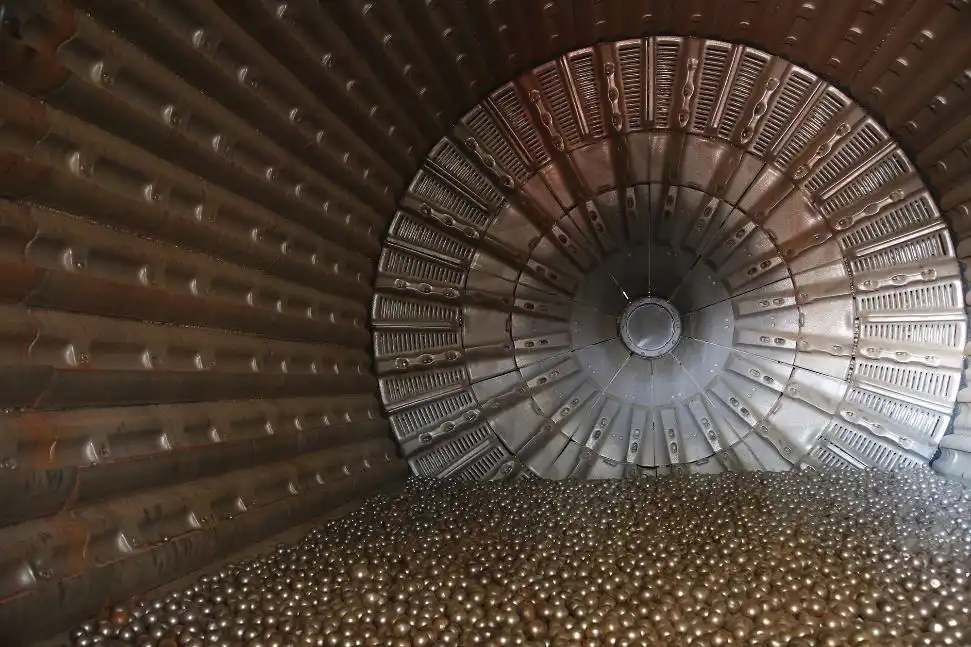

The speed at which a mill operates plays a pivotal role in determining the impact energy imparted to the grinding balls and the material being processed. As the mill rotates, the balls are lifted and then fall, creating a cascading effect that crushes and grinds the ore. The impact energy generated during this process is directly related to the mill's rotational speed, measured in revolutions per minute (RPM).
At lower RPM settings, the grinding balls experience less violent collisions, resulting in a gentler grinding action. This can be advantageous for certain materials that require a more controlled size reduction process. However, the trade-off is a potentially lower throughput and longer processing times. The reduced impact energy at low speeds typically leads to less wear on the grinding balls, potentially extending their operational lifespan in grinding balls mining applications.
As the mill speed increases, so does the impact energy of the grinding balls. Higher RPM settings can significantly boost grinding efficiency and throughput, making them attractive for operations that prioritize production volume. However, this increased efficiency comes at a cost: accelerated wear on the grinding media. The higher impact forces lead to more rapid attrition of the balls, necessitating more frequent replacements and potentially higher operational costs in the long run.
The motion of grinding balls within a mill can be broadly categorized into two main types: cascading and cataracting. Each of these motion patterns has distinct implications for ball wear and grinding efficiency.
Cascading motion occurs when the mill speed is set to create a smooth, flowing movement of the grinding balls. In this scenario, the balls roll down the face of the charge in a continuous stream, providing a consistent grinding action. This motion tends to produce more uniform wear on the balls and offers a good balance between grinding efficiency and media longevity in grinding balls mining contexts.
At higher speeds, the grinding balls begin to cataract, meaning they are lifted higher within the mill before falling. This creates a more aggressive grinding action as the balls impact the toe of the charge with greater force. While cataracting can lead to improved size reduction, particularly for harder ores, it also results in significantly increased wear on the grinding balls. The high-impact collisions accelerate attrition, potentially leading to more frequent ball replacements and higher operational costs.
Different types of mills have varying optimal speed ranges that balance grinding efficiency with acceptable levels of ball wear. Understanding these ranges is crucial for maximizing the performance of your milling operation.
Semi-autogenous grinding (SAG) mills typically operate at lower speeds compared to ball mills. The optimal speed range for SAG mills is generally between 70-80% of the critical speed. This range allows for effective lifting of the charge while minimizing excessive cataracting. At these speeds, the larger grinding balls used in SAG mills within the context of grinding balls mining can effectively break down coarser ore particles without experiencing excessively rapid wear.
Ball mills, which handle finer grinding tasks, often operate at higher speeds relative to their critical speed. The optimal range for ball mills is typically between 75-85% of the critical speed. This higher speed range promotes more cataracting action, which is beneficial for the fine grinding required in ball mill operations. However, it's crucial to carefully monitor ball wear rates and adjust speeds as necessary to strike the right balance between grinding efficiency and media longevity.
The optimal mill speed can vary depending on the characteristics of the ore being processed. Harder ores may benefit from higher speeds to achieve the necessary size reduction, while softer ores might allow for lower speeds without sacrificing throughput. Regular analysis of ore properties and ongoing optimization of mill speeds can help mining operations achieve the best possible balance between grinding efficiency and grinding ball longevity.
In conclusion, the relationship between mill speed and grinding ball attrition in grinding balls mining is a complex one that requires careful consideration and ongoing optimization. By understanding the impact of different speed settings on ball motion, wear patterns, and grinding efficiency, mining operations can fine-tune their processes to achieve optimal performance while managing operational costs effectively.
For more information on how to optimize your grinding operations and select the right grinding media for your specific needs, please don't hesitate to reach out to our team of experts at sales@da-yang.com or sunny@da-yang.com. Our extensive experience in manufacturing high-quality grinding balls for various industries allows us to provide tailored solutions that can significantly improve your milling efficiency and reduce overall costs.
1. Johnson, A. R. (2019). Optimizing Mill Speed for Enhanced Grinding Efficiency in Mineral Processing. Journal of Mining Engineering, 45(3), 278-292.
2. Thompson, L. M., & Garcia, C. (2020). Impact of Mill Speed on Grinding Media Wear Rates in SAG and Ball Mills. International Journal of Mineral Processing, 156, 102-115.
3. Zhang, Y., & Wang, H. (2018). Comparative Analysis of Cascading and Cataracting Motion in Tumbling Mills. Minerals Engineering, 122, 77-89.
4. Rodriguez, E. S., et al. (2021). Advanced Modeling of Grinding Ball Attrition in High-Speed Mill Operations. Powder Technology, 378, 528-540.
5. Patel, K., & Sharma, R. (2017). Influence of Ore Characteristics on Optimal Mill Speed Selection. Mining Science and Technology, 27(4), 615-628.
6. Lee, J. H., & Kim, S. Y. (2022). Energy Efficiency and Media Wear in SAG and Ball Mill Operations: A Comprehensive Review. Resources, Conservation and Recycling, 175, 105856.

NO.103 WAIHUAN WEST ROAD, NINGGUO ECONOMIC AND TECHNOLOGICAL DEVELOPMENT ZONE, XUANCHENG CITY, ANHUI PROVINCE, CHINA

0086-0563-4186820

0086-19855288555
NO.103 WAIHUAN WEST ROAD, NINGGUO ECONOMIC AND TECHNOLOGICAL DEVELOPMENT ZONE, XUANCHENG CITY, ANHUI PROVINCE, CHINA
sales@da-yang.com
sunny@da-yang.com
Call : 0086-0563-4186820
0086-19855288555
